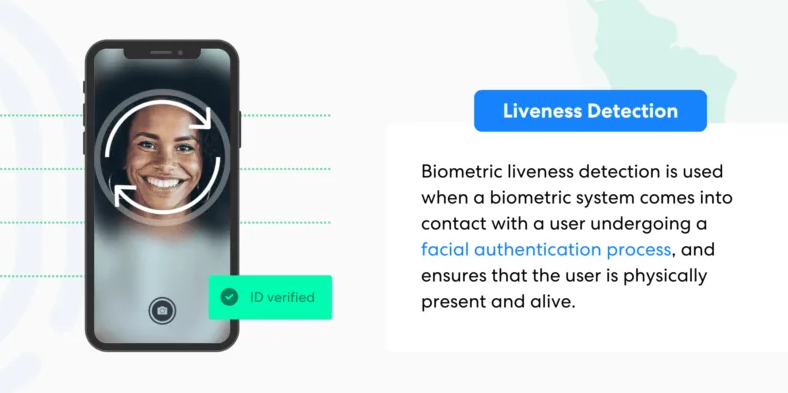Have you ever wondered how digital media can distinguish between a fake and a real face in a camera?
Liveness detection has become one of the most crucial technologies in the era of deepfakes and AI-generated content, ensuring safety, genuineness, and naturalism in video production.
Not only does this technology protect users against fraud, but it also redefines the integration of artificial intelligence with creative video workflows.
What Is Liveness Detection?
Before we can learn about its effect, we must first answer the following: What is liveness detection?
Simply put, liveness detection is a security procedure that ascertains the possibility of the camera recording an actual human being or a false counterfeit of a photo, mask, or video recording.
It is a biometric security that is commonly applied in facial recognition, online identity checks, and fraud detection systems.

The next generation of liveness systems relies on AI-based algorithms to detect minute actions, e.g., blinking, lip movement, and muscle tension of the face.
These micro-expressions are useful in determining whether the interaction is genuine. Banks, video conferencing applications, and even social media use it now to make sure that there is an actual human face behind the live communications.
The AI Applicability in Liveness Detection
Liveness detection depends on artificial intelligence. The artificial intelligence models are trained using millions of face images in different lighting conditions, angles, and expressions to identify true human features.
In contrast to the traditional verification systems, the AI-based liveness systems adjust to environmental factors. They can detect fakes even in cases when the lighting or video quality changes.
Deep learning networks are also more accurate based on studying the time patterns of the frames of a video.

To take an example, AI can distinguish a stationary picture and a moving face based on the analysis of motion depth.
Such a combination of biometric science and AI guarantees a smooth identity check without human verification, and processes are secure and efficient.
Liveness Detection on the Face in Practice
Digital onboarding and authentication solutions have made face liveness detection a fundamental feature. It does not stop at the facial recognition; it authenticates the authenticity of the individual under scan.
Practically, the user may be requested to blink, smile, or turn their head a bit. AI examines these tiny motions to ensure that the face is of a living individual.
This is an essential strategy in averting spoofing attacks, whereby fraudsters apply high-quality pictures or deepfake videos to impersonate the identity of a person.
This kind of technology is already applied in digital banking applications, eKYC (Know Your Customer), and secure login menus of log-in.
The outcome: Identity validation will be faster, less risk of fraud will be present, and user trust will improve.
Video Liveness Detection Production
Video liveness detection is not confined to security; it is also defining modern video production. The AI-based systems work through each frame to identify discrepancies, light anomalies, or fake overlays to suggest manipulation.
This assists editors in being realistically involved in the production of digitally enhanced scenes.
The use of AI in movie production allows for creating continuity and visual integrity in the film by automatically choosing between an actual actor and a digital duplicate of a real actor.
This comes in handy, especially when combining both live-action shots and CGI or virtual characters. The technology makes what viewers watch on the screen authentic, emotionally involving, and believable.
Active Liveness Detection: Moving Forward
Passive liveness detection is based on background analysis of an image or video, whereas active liveness detection requires the involvement of users.
The system prompts the actions, like nodding, blinking, or uttering a phrase, and the AI analyzes such dynamic actions in real-time.
The technique goes a long way in limiting spoofing. It is also being incorporated with AR/VR spaces, which is why creators and developers can authenticate users within the immersive digital worlds.
Active liveness detection will make virtual communication, whether in a game or during digital creation or even during remote interviews, safe and authentic.
Artificial Intelligence in Video Production: The Power of Fusion of Creativity and Integrity
The general idea of AI in video production is transforming the world of media. AI technology accelerates the process of creativity in production and allows for real-time visual effects, automated video editing, and recognition of scenes, in addition to consistently producing high-quality work.
However, when it is combined with liveness detection, a new integrity level is added. As an example, in the case of live broadcasting, AI will be able to identify manipulative images or fake facial data and stop the spread of misinformation.
In entertainment, it makes sure that digital doubles or AI avatars imitate human emotions properly without any ethical or deceptive boundaries.
This means that AI is not simply enhancing production efficiency; it is ensuring that truth has been upheld in the visual world.
Liveness Detection in the Future
Liveness verification systems of the future comprise a hybrid of AI, 3D verification, and behavioral biometrics.
We are heading to the age of invisible real-time authentication. The depth, temperature, and pulse variations will be detected by cameras and sensors and will be used to verify presence without disrupting the user experience.
In creative products, it will imply more secure virtual teams, content that can never be scammed, and a better combat of deepfakes.
The significance of authenticating the video will increase as the video becomes the language of the internet.
Conclusion
In a digitalized world that is full of illusions created on computers, liveness detection is a protector of the truth and genuineness.
It can guarantee not only that what we are looking at, be it in a security system or on the cinema screen, is real by incorporating the biometric accuracy with the analytical capabilities of AI.
With the continued evolution of AI in video production, it is this technology and integrity that will develop the next generation of reliable and natural digital experiences.








